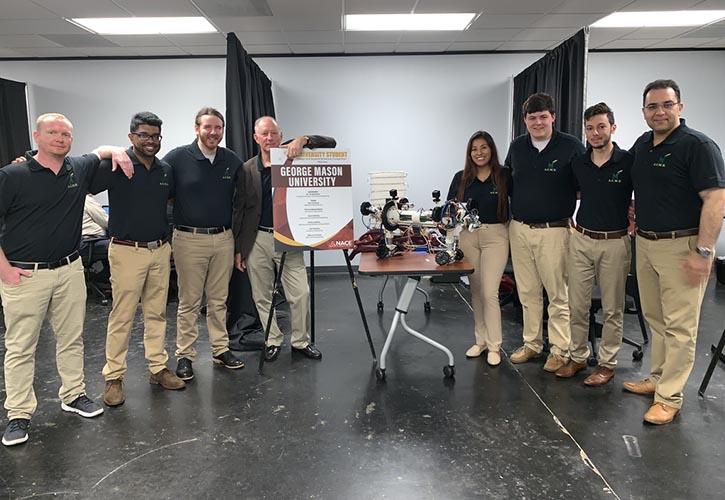“Creative problem solving is the core of engineering, so it was great to see how everyone’s creativity came to life after a nine-month development phase.”
Farbod Moghaddam
For three consecutive years, Mason Engineering students have competed in the University Student Design and Applied Solutions Competition (USDASC) sponsored by the National Association of Corrosion Engineers (NACE).
This year’s team managed to place higher than ever before, earning second place against teams from the United States Naval Academy, United States Air Force Academy, United States Military Academy at West Point, Arizona State University, and Louisiana State University.
The annual competition gives students a platform to showcase their engineering design and problem-solving skills by presenting them with corrosion-related problems similar to those that compromise the operational safety of companies, such as BP oil, and cost the U.S. over $450 billion annually.
As is often the case when working in a team, the students learned not just technical knowledge but also valuable interpersonal lessons. “Talking with the different teams to gauge how they reached their final products was by far the most rewarding aspect of the competition,” says senior Farbod Moghaddam, the Mason team lead. “We found that we shared similar struggles, ideas, and overall approaches even though no two systems were the same.”
The Mason Engineering Autonomous Corrosion-detecting Mechanized Explorer (A.C.M.E) team developed a robotic solution that can locate and characterize instances of material degradation as small as one millimeter in diameter with less than two percent error. The robot weighs about 30 pounds and is 36 inches long (54 inches with its sensing arm fully extended). The brain of the robot consists of three Raspberry Pi microcomputers.
It takes five minutes to set up the robot before it is ready to start inspecting. To operate it, the user connects to a local area network (LAN) shared with the computers through an ethernet cable.
Once one of the robot’s cameras detects corrosion, the user snaps a picture of the area using a built-in command. The picture is then processed using a Python script that automatically characterizes areas of interest, delivering information such as the sizes, locations, and types of corrosion detected.
During the development of their project, the students were reminded that it is better to design a product that is functional and meets the client’s requirements than to expect perfection. “Sometimes engineers can lose sight of what really matters—like the customer’s specifications—in pursuit of a perfect product,” says Moghaddam.
The Department of Defense Corrosion Policy and Oversight Office sponsored this project with Richard Hays and Richard Frey serving as primary contacts.
“If I could say one thing other than thank you to our sponsors. it would be to please continue their investment in student projects,” says Moghaddam. “In my opinion, there is no better way to find an innovative solution than to allow a group of motivated young engineers to test ideas that others might not.”

The team stops to pose with the robot shortly after inspection and testing. Team members from left to right are Joe Hawkey, Senil Mathes, Malcolm Forbes, Professor Robert Gallo, Emily Cadima, Jack Scherer, Farbod Moghaddam, Professor Ali Beheshti. (Courtesy photo)
The A.C.M.E. team is one of 22 student teams that will participate in the Third Annual Design Capstone Day at the Hub Student Center Ballroom on May 2, 2019.
